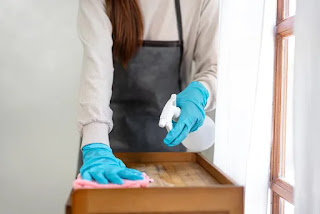How To Remove Mold & Mildew From Wood Furniture | With Vinegar
Introduction
If you notice mould such as black mould on your beloved
wooden furniture, it can be very frustrating and most importantly, it can be
dangerous to walls, carpets and furniture items in particular. Black mould can
also be very dangerous for your health, so it is very important to get rid of
the mould as soon as you notice it in your home. Now, you must be wondering: How
to remove mould from wood furniture? Don't worry, because vinegar can be a great
option in your fight against this stubborn intruder. In this detailed guide,
we'll explore how to effectively get rid of mould from wooden furniture using
vinegar.
Understanding Mold Growth on Wooden Furnishings
Before getting straight to the removal process, it is
essential to understand the reason behind the mould growth on wooden furniture.
Mould continues to increase or flourish in damp and dark environments, which in
turn, makes wooden surfaces vulnerable, particularly, in humid
climates or damp conditions. As soon as the mould starts to grow, it not only damages
the look of your furniture but can also pose health problems. So, it is
important to remove the mould from wood furniture as soon as possible.
The Power of Vinegar in Mold Removal
Vinegar, which is a common household item & well-recognized for its versatility, can be a great solution to remove mould from
wooden furniture. Vinegar contains acidic properties that help to break down
the structure of mould, which in turn stops it from growing and making it easier
to remove.
Steps to Remove Mould with Vinegar
Here's a step-by-step guide to using vinegar when it
comes to removing mould from wooden furniture:
1.
Prepare the Solution: First of all, take
a spray bottle and mix equal parts of distilled white vinegar and water in it.
This diluted mixture will be very effective and surely will kill mould without
damaging the wood.
2.
Safety First: While using vinegar to remove mould, it is
important to wear gloves and a mask as it will protect you from mould spores and
vinegar fumes.
3. Apply the Solution: Now, spray the
vinegar solution onto those areas of the wooden furniture that are affected by
the mould. Allow the vinegar solution to sit on the affected spot for a while in
order to penetrate the mould.
4. Gently Scrub: Next, gently scrub the
mould-infested areas with the help of a soft-bristled brush or sponge. Be very careful
not to scratch the wood.
5. Rinse and Dry: After scrubbing, it is
time to rinse the furniture with clean water that will help remove any leftover
vinegar solution and loosened mould particles. Then, dry the surface thoroughly in
order to prevent mould from coming back.
6. Sunlight Exposure: Finally, place the
furniture in a well-ventilated area also making sure to expose it to sunlight.
Sunlight has natural disinfectant properties that can be very helpful to
prevent mould growth.
Preventive Measures to Protect Your Wooden Furnishings
While vinegar is considered one of the best options for
removing mould, it's important to take preventive measures in order to prevent
the mould from coming back. Here are some tips:
- Maintain
Optimal Humidity Levels: Use a dehumidifier to control indoor humidity
levels and stop mould growth.
- Ensure
Good Ventilation: Make sure there's proper airflow in your home in order to
prevent moisture buildup, especially around furniture.
- Clean
Up Spills Promptly: Deal with spills or leaks immediately after noticing
the mould in order to prevent moisture from seeping into wooden furniture.
- Regular
Cleaning: Keep your furniture clean using mild, wood-safe cleaners to
prevent dust buildup and mould growth.
Conclusion
With vinegar as your secret weapon, you can effectively
& efficiently take action to reduce or prevent mould infestations on wooden
furniture in an eco-friendly and affordable way. By following the above-mentioned steps and taking preventive measures, you can keep your cherished
wooden furnishings looking beautiful for years to come.





Comments
Post a Comment